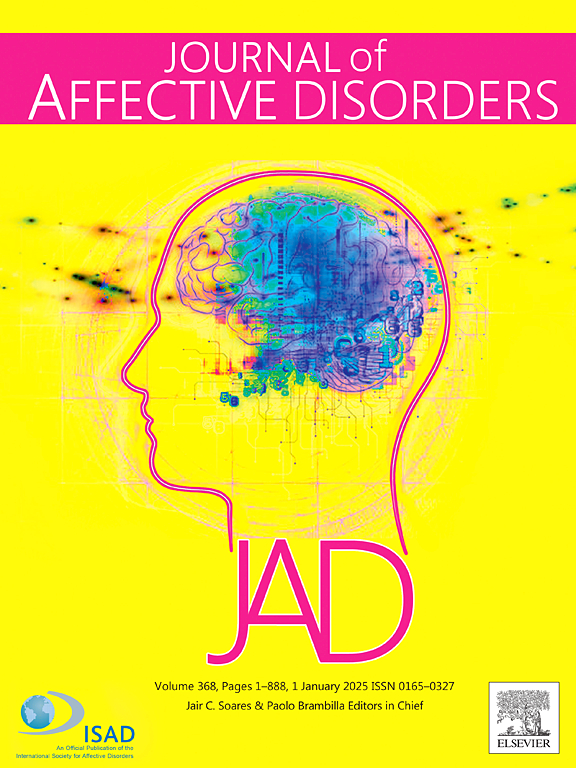c反应蛋白与情绪障碍神经影像学表现之间的关系:结构和扩散MRI研究综述。
IF 4.9
2区 医学
Q1 CLINICAL NEUROLOGY
引用次数: 0
摘要
背景:情绪障碍,包括重度抑郁障碍(MDD)和双相情感障碍(BD),通常具有大脑结构改变,这可能与周围炎症有关。在这方面,c反应蛋白(CRP)与这些改变有关。本文综述了结构和扩散磁共振成像(MRI)在心境障碍患者中CRP水平与神经影像学表现之间的关系。方法:遵循PRISMA指南,在2024年9月之前通过Scopus、PubMed、Web of Science和Embase进行系统检索,重点研究CRP水平与情绪障碍患者结构和/或微结构脑改变之间的关系。结果:本系统综述包括20项研究,研究外周血CRP水平或基于DNA甲基化的CRP (DNAm CRP)特征与情绪障碍大脑结构改变之间的关系。研究结果显示了相当大的变异性;然而,一致的模式出现了,高CRP水平与灰质体积减少和皮层变薄有关,特别是在前额皮质(PFC)、海马体、内嗅皮质、脑岛和尾状核。弥散成像一致显示白质完整性降低,关键束如内囊、扣带束和胼胝体(CC)受到明显影响。结论:总的来说,这些发现表明,全身性炎症,反映在CRP或DNAm CRP升高,有助于情绪障碍神经变性和轴突完整性受损的结构改变。研究之间的差异突出了疾病严重程度、治疗史和不同炎症介质的潜在影响。未来采用标准化成像方案和纵向设计的研究对于阐明炎症的机制作用和确定情绪障碍中大脑结构改变的可靠生物标志物至关重要。本文章由计算机程序翻译,如有差异,请以英文原文为准。
The association between C-reactive protein and neuroimaging findings in mood disorders: A review of structural and diffusion MRI studies
Background
Mood disorders, including major depressive disorder (MDD) and bipolar disorder (BD), often share structural brain alterations, which may be linked to peripheral inflammation. In this regard, C-Reactive Protein (CRP) has been associated with these alterations. This review explores the relationship between CRP levels and neuroimaging findings in mood disorders using structural and diffusion Magnetic Resonance Imaging (MRI).
Methods
Following PRISMA guidelines, a systematic search was conducted through Scopus, PubMed, Web of Science, and Embase before September 2024, focusing on studies evaluating associations between CRP levels and structural and/or microstructural brain alterations in mood disorders.
Results
The present systematic review included 20 studies examining the associations between peripheral CRP levels or DNA methylation-based CRP (DNAm CRP) signatures and structural brain alterations in mood disorders. Findings showed considerable variability; however, consistent patterns emerged, linking higher CRP levels to reduced grey matter volumes and cortical thinning, particularly in the prefrontal cortex (PFC), hippocampus, entorhinal cortex, insula, and caudate. Diffusion-based imaging consistently indicated reduced white matter integrity, with significant effects in key tracts such as the internal capsule, cingulum bundle, and corpus callosum (CC).
Conclusions
Overall, these findings suggest that systemic inflammation, reflected by elevated CRP or DNAm CRP, contributes to structural alterations indicative of neurodegeneration and compromised axonal integrity in mood disorders. Discrepancies among studies highlight potential influences of disease severity, treatment history, and distinct inflammatory mediators. Future research employing standardized imaging protocols and longitudinal designs is essential to clarify inflammation's mechanistic roles and identify reliable biomarkers of structural brain alterations in mood disorders.
求助全文
通过发布文献求助,成功后即可免费获取论文全文。
去求助
来源期刊

Journal of affective disorders
医学-精神病学
CiteScore
10.90
自引率
6.10%
发文量
1319
审稿时长
9.3 weeks
期刊介绍:
The Journal of Affective Disorders publishes papers concerned with affective disorders in the widest sense: depression, mania, mood spectrum, emotions and personality, anxiety and stress. It is interdisciplinary and aims to bring together different approaches for a diverse readership. Top quality papers will be accepted dealing with any aspect of affective disorders, including neuroimaging, cognitive neurosciences, genetics, molecular biology, experimental and clinical neurosciences, pharmacology, neuroimmunoendocrinology, intervention and treatment trials.
 求助内容:
求助内容: 应助结果提醒方式:
应助结果提醒方式:


